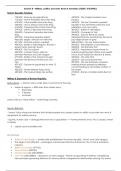Class notes
Introducing Roman History - Section B & C - SLL1097S
- Course
- SLL1097S (SLL1097S)
- Institution
- University Of Cape Town (UCT)
Comprehensive Roman History (SLL1097S) Study Guide This document includes: Section B: Roman Republic Timeline Military & Expansion Senate & Politics Early Rome & Methodologies Past Paper Questions Section C: Augustus and Beyond Timeline Augustus' Divestment of Triumvi...
[Show more]



